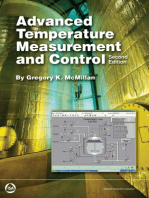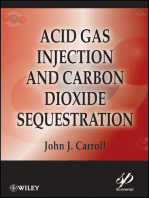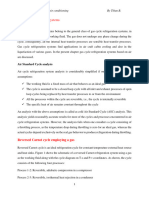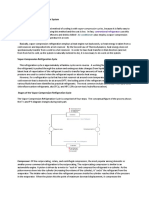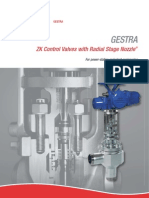Tariq LNG
Tariq LNG
Uploaded by
ganeshanCopyright:
Available Formats
Tariq LNG
Tariq LNG
Uploaded by
ganeshanOriginal Title
Copyright
Available Formats
Share this document
Did you find this document useful?
Is this content inappropriate?
Copyright:
Available Formats
Tariq LNG
Tariq LNG
Uploaded by
ganeshanCopyright:
Available Formats
LNG technology
selection
Dr Tariq Shukri, Foster Wheeler, UK, discusses available LNG technologies and the important criteria for selection.
echnology selection starts at an early stage in the life of a baseload LNG project and is typically addressed at the feasibility study and pre-FEED definition stages. Process routes must be chosen for the process, utilities and offsite units of the plant, which include proprietary and nonproprietary technologies. This also applies to the upstream part of the chain, which supplies the gas to the plant. Potential options must be identified and evaluation criteria established. The selection could be between alternative processing technologies for the operating units, the type of major equipment, or utilities schemes. This article presents an overview of the LNG process and an introduction to the main processes available for the liquefaction section of a baseload LNG plant. It also discusses some selection issues relating to the main technologies that affect LNG plant configuration.
Liquefaction technology
The refrigeration and liquefaction section is the key element of the LNG plant. There are several licensed processes available with varying degrees of application and experience. There are others proposed or under development but are not considered here. The basic principles for cooling and liquefying the gas using refrigerants involve matching as closely as possible the cooling/heating curves of the process gas and the refrigerant. This results in a more efficient thermodynamic process requiring less power per unit of LNG produced. This applies to all liquefaction processes. Typical cooling curves are shown in Figure 2. However, the way this is achieved and the equipment used play a major part in the overall efficiency, operability, reliability and cost of the plant. The liquefaction section typically accounts for 30 - 40% of the capital cost of the overall plant. Key equipment items include the compressors used to circulate the refrigerants, the compressor drivers and the heat exchangers used to cool and liquefy the gas and exchange
The LNG process
An example of a LNG plant overall flow scheme, and the main process units and supporting utilities, is shown in Figure 1. The process and utility requirement depend, amongst other things, on the site conditions, feed gas quality and product specification. In a typical scheme the feed gas is delivered at high pressure (for example, up to 90 bara) from upstream gas fields via trunk lines and any associated condensate will be removed. The gas is metered and its pressure controlled to the design operating pressure of the plant. The gas is first pre-treated to remove any impurities that interfere with processing or are undesirable in the final products. These include acid gases and sulphur compounds (for example, CO2, H2S and mercaptans), water and mercury. The dry sweet gas is then cooled by refrigerant streams to separate heavier hydrocarbons. The remaining gas is made up mainly of methane and contains less than 0.1 mol% of pentane and heavier hydrocarbons. It is further cooled in the cryogenic section to approximately -160 C and is completely liquefied. The resulting LNG is stored in atmospheric tanks ready for export by ship. The heavier hydrocarbons separated during cooling are fractionated to recover ethane, propane and butane. Ethane is normally reinjected into the gas stream to be liquefied. The propane and butane can either be reinjected or exported as LPG products. The remaining hydrocarbons (pentane and heavier components) are exported as a gasoline product. The utilities required to support the processing units include fuel gas (derived from the process streams) to generate electric power, cooling medium (water or air), heating medium (steam or hot oil system), and other services such as instrument air and nitrogen.
Figure 1. LNG block flow diagram.
Figure 2. Typical natural gas/refrigerant cooling curves.
Reprinted from HYDROCARBON ENGINEERING FEBRUARY 2004
parameter as it can be made either from pure or mixed components. With a mixed refrigerant the composition can be adjusted to suit the process conditions. The heat exchangers used, for example, the spiral/coil wound heat exchangers (CWHE) or the plate fin heat exchangers (PFHE), have very large surface areas and a large number of passes, enabling close temperature approaches. The main available liquefaction processes are described below. The MCRTM process will be described in greatest detail. Many of the principles apply to other processes. The main differences will be highlighted.
Figure 3. APCI propane precooled mixed refrigerant process (typical).
APCI propane pre-cooled mixed refrigerant process (MCR)
Figure 4. Phillips optimised cascade process.
Figure 5. Black & Veatch PRICO process.
heat between refrigerants. For recent baseoad LNG plants this equipment is among the biggest of its type and at the leading edge of technology. The natural gas, being a mixture of compounds, liquefies over a wide temperature range. Heat curves can be matched by minimising the temperature difference between the cooling process gas and refrigerant streams. This is achieved by using more than one refrigerant to cover the temperature range and using the refrigerant at different pressure levels to further split the temperature ranges to closely matching ones. The process gas side is normally operated at high pressure (for example, 40 - 55 bara) to reduce equipment size and provide more efficient refrigeration. The composition of the refrigerant gives an added control
This process accounts for a very significant proportion of the worlds baseload LNG production capacity. Train capacities of up to 4.7 million tpy were built or are under construction. It is illustrated in Figure 3 as part of an overall LNG plant flow scheme. There are two main refrigerant cycles. The precooling cycle uses a pure component, propane. The liquefaction and sub-cooling cycle uses a mixed refrigerant (MR) made up of nitrogen, methane, ethane and propane. The precooling cycle uses propane at three or four pressure levels and can cool the process gas down to -40 C. It is also used to cool and partially liquefy the MR. The cooling is achieved in kettle-type exchangers with propane refrigerant boiling and evaporating in a pool on the shell side, and with the process streams flowing in immersed tube passes. A centrifugal compressor with side streams recovers the evaporated C3 streams and compresses the vapour to 15 - 25 bara to be condensed against water or air and recycled to the propane kettles. In the MR cycle, the partially liquefied refrigerant is separated into vapour and liquid streams that are used to liquefy and sub-cool the process stream from typically -35 C to between -150 C - -160 C. This is carried out in a proprietary spiral wound exchanger, the main cryogenic heat exchanger (MCHE). The MCHE consists of two or three tube bundles arranged in a vertical shell, with the process gas and refrigerants entering the tubes at the bottom which then flow upward under pressure. The process gas passes through all the bundles to emerge liquefied at the top. The liquid MR stream is extracted after the warm or middle bundle and is flashed across a Joule Thomson valve or hydraulic expander onto the shell side. It flows downwards and evaporates, providing the bulk of cooling for the lower bundles. The vapour MR stream passes to the top (cold bundle) and is liquefied and sub-cooled, and is flashed across a JT valve into the shell side over the top of the cold bundle. It flows downwards to provide the cooling duty for the top bundle and, after mixing with liquid MR, part of the duty for the lower bundles. The overall vaporised MR stream from the bottom of the MCHE is recovered and compressed by the MR compressor to 45 - 48 bara. It is cooled and partially liquefied first by water or air and then by the propane refrigerant, and recycled to the MCHE. In earlier plants all stages of the MR compression were normally centrifugal, however, in some recent plants axial compressors have been used for the LP stage and centrifugal for the HP stage. Recent plants use Frame 6 and/or
Reprinted from HYDROCARBON ENGINEERING FEBRUARY 2004
achieved in a cascade process using three pure component refrigerants; propane, ethylene and methane, each at two or three pressure levels. This is carried out in a series of brazed aluminium PFHEs arranged in vertical cold boxes. Precooling could be carried out in a core-in-kettle type exchanger. The refrigerants are circulated using centrifugal compressors. Each refrigerant has parallel compression trains. Frame 5 gas turbine drivers were used.
Black & Veatch PRICO process
This is a single mixed refrigerant process used on an earlier baseload plant in Algeria. Train capacity has been uprated to 1.3 tpy per train. It is illustrated in Figure 5. The mixed refrigerant is made up of nitrogen, methane, ethane, propane and iso-pentane. The cooling and liquefaction is carried out at several pressure levels, in PFHEs in cold boxes. The refrigerant is compressed and circulated using a single compression train. In the Algerian plant axial compressors driven by steam turbines were used.
Statoil/Linde mixed fluid cascade process (MFCP)
Figure 6. Statoil/Linde mixed fluid cascade process (MFCP).
Frame 7 gas turbine drivers. Earlier plants used steam turbine drivers. A recent modification of the process, which is being considered for large LNG capacity plants (> 6 million tpy), is the APX-process, which adds a third refrigerant cycle (nitrogen expander) to conduct LNG subcooling duties outside the MCHE. In this process three mixed refrigerants are used to provide the cooling and liquefaction duty. It has been selected for the Snhvit LNG project (Ekofisk, Norway) which is under design/construction. This is a single train 4 million tpy LNG plant. The process is illustrated in Figure 6. Pre-cooling is carried out in PFHE by the first mixed refrigerant, and the liquefaction and subcooling are carried out in a spiral wound heat exchanger (SWHE) by the other two refrigerants. The SWHE is a proprietary exchanger made by Linde. It may also be used for the pre-cooling stage. The refrigerants are made up of components selected from methane, ethane, propane and nitrogen. The three refrigerant compression systems can have separate drivers or integrated to have two strings of compression. Frame 6 and Frame 7 gas turbine drivers have been proposed for large LNG trains (> 4 million tpy). A novel feature of the Snhvit project is that all motor drivers will be used for the main refrigerant compressors, with sizes up to 60 MW. The SWHE itself is being installed with other liquefaction processes, in new and expansion projects or as a replacement for old cryogenic exchangers.
Phillips optimised cascade process
This process, a modified version of a process used in an earlier plant in Alaska during the 1960s, was used for the Atlantic LNG plant in Trinidad and for a baseload plant under construction in Egypt. Train capacities of up to 3.3 million tpy have been constructed with larger trains in development. This process is illustrated in Figure 4. Refrigeration and liquefaction of the process gas is
Table 1. Some technology selection parameters Technology selection items Pros Spiral wound exchanger Flexible operation PFHE Competitive vendors available. Lower pressure drop and temperature differences Axial compressors High efficiency Large gas turbines
Large motor drivers
Mixed refrigerant process
Pure component cascade process Air cooling (compared to sea water cooling) Fluid medium heating (compared to steam) Larger train capacity
Cons Proprietary/more expensive Require careful design to ensure good 2-phase flow distribution in multiple exchanger configurations Suitable only at high flow rates. Proven, efficient and cost Less reliable/strict effective maintenance cycle/ more complicated control /fixed speed Efficient, flexible & more Untried in LNG at speeds available needed/require large power plant. Simpler compression system. More complex operation. Adjusting composition allows process matching Potential higher availability More equipment and with parallel compression complicated compression system Lower cooling system Less efficient process CAPEX /higher operating costs Eliminates the need for Higher reboiler costs steam generation & water treatment Lower specific costs Some equipment/ (CAPEX per tonne LNG) processes may require further development
Axens Liquefin process
This is a two-mixed refrigerant process, which is being proposed for some new LNG base load projects of train sizes up to 6 million tpy. It is illustrated in Figure 7. Detailed studies have been made including input from main equipment vendors. All cooling and liquefaction is conducted in PFHE arranged in cold boxes. The refrigerants are made up of components from methane, ethane, propane, butane and nitrogen. The first mixed refrigerant is used at three different pressure levels to precool the process gas and precool and liquefy the second mixed refrigerant. The second mixed refrigerant is used to liquefy and subcool the process gas. Using a mixed refrigerant for the precooling stage allows a lower temperature to be achieved (for example, -60 C) depending on refrigerant composition. The PFHEs are non-proprietary and can be supplied by independent vendors. Two large drivers can drive the refrigerant compression systems. Frame 7 gas turbines are being proposed
Reprinted from HYDROCARBON ENGINEERING FEBRUARY 2004
Figure 7. Axens Liquefin process.
for the large LNG trains.
produce LNG, is not solely related to the thermodynamic efficiency of the liquefaction process but also to the efficiency of the main equipment such as the main refrigerant compressors and drivers. Site conditions may favour one type of process over another. For example, with very cold ambient temperatures multi-mixed refrigerant processes may offer the optimum solution. Process requirements and configuration will have an influence on selection. A requirement for greater LPG recovery may suit processes with lower precooling temperatures. Wider feed gas range will require better process adaptability and may favour mixed refrigerant processes with the added flexibility of changing refrigerant composition. Refrigerants made up from components that can be produced in the process (in the fractionation unit) will obviate the need for external supply to make up refrigerant losses.
Compressors and drivers Shell double mixed refrigerant process (DMR)
This is a dual mixed refrigerant process, which is being applied in the Sakhalin Island project with a capacity of 4.8 million tpy per train. Process configuration is similar to the propane pre-cooled mixed refrigerant process, with the precooling conducted by a mixed refrigerant (made up mainly of ethane and propane) rather than pure propane. Another main difference is that the precooling is carried out in SWHEs rather than kettles. The precooling and liquefaction SWHEs will be supplied by Linde. The refrigerant compressors are driven by two Frame 7 gas turbines. An axial compressor is also used as part of the cold refrigerant compression stages. The rotating equipment selection is affected by the characteristics of the process, such as composition and flow rate of the refrigerant and head required. Some will fit available frames and casings while others will require some development. The choice of drivers, compressors and driver arrangements, and their fit with the process and power generation is critical to the selection process. The larger the drivers and compressors the more efficient and cost effective they are likely to be. However, if some machinery is limited by available designs, smaller proven equipment may be installed in parallel trains, offsetting increased costs by higher availability. The choice of drivers for the main compressors is not limited to gas and steam turbines. Studies carried out by Foster Wheeler have shown that the use of large electric motor drivers is a feasible option to support high capacity baseload LNG plants. The selection of cooling system will have an impact on compressor design, as it dictates compressor interstage and discharge conditions. Often the selection of process and drivers, particularly for expansion projects, is dictated by the desire to stay with familiar designs and configurations and to standardise sparing, etc.
Other processes
The above processes are used in current LNG plants or are applied in LNG projects in progress. There are other processes developed or in development for baseload LNG applications, which can be or are being considered in feasibility studies or for future projects but are not discussed here. The trend is to extend the capability of existing processes and develop new processes to support large LNG capacities of over 5 million tpy per train. Larger train capacities result in lower specific costs.
Equipment
All the main processes are licensed processes, and some also use proprietary equipment. The main spiral wound heat exchangers used by APCI and Linde are both proprietary. Tube leakage problems experienced previously with some designs of spiral wound exchangers have been addressed several years ago and minimised. The PFHEs used by some processes are non-proprietary and can be offered by different vendors. Installations on large capacity plants comprising multiple parallel exchangers require more careful design for two phase (vapour and liquid) flow conditions within the unit. Some other considerations for equipment selection are given in Table 1.
Process selection
Technology selection of process and equipment will be based on technical and economic considerations. Foster Wheeler has carried out selection studies as part of major LNG projects and proposals during the various phases of feasibility, FEED and detailed engineering. In addition to an extensive in-house LNG database, contacts are made with the liquefaction licensors and main equipment vendors to obtain data and develop designs to enable valid comparisons and optimum selections. Depending on the stage of project development, sufficient process details must be developed to define main equipment and operating parameters to evaluate options using relevant criteria. Technical considerations include process and equipment experience, reliability, process efficiency, site conditions and environmental impact. Economic issues include capital cost, operating cost and lifecycle costing. All of these aspects will need to be evaluated to arrive at the optimum solution. Technical risks associated with a process relate to the track record of the process in operation, and any developments required for the project for example, capacity increase. Process efficiency, for example, energy required to
Other selections
Another important area is deciding the heating and cooling media types as they directly impact process and equipment. Cooling medium is normally a choice between air and water in a direct or indirect system. For the heating medium, steam or hot oil systems can be considered. For example a selection of air for cooling, oil for heating and gas turbine drivers eliminates the need for a steam generation system including water treatment, and a cooling water system which may include a costly seawater intake. The above criteria are typical of the main issues that must be considered when selecting the technology for an LNG plant.
Reprinted from HYDROCARBON ENGINEERING FEBRUARY 2004
You might also like
- LNG c3mr ProcessDocument8 pagesLNG c3mr ProcessFatih FıratNo ratings yet
- MLNG Dua Debottlenecking ProjectDocument10 pagesMLNG Dua Debottlenecking ProjectthawdarNo ratings yet
- Lab Report 560751c42519eDocument16 pagesLab Report 560751c42519eNadiaNo ratings yet
- Advanced Temperature Measurement and Control, Second EditionFrom EverandAdvanced Temperature Measurement and Control, Second EditionNo ratings yet
- 1745 2018 Petroleum Hydrocarbon Solvents - Specification Third RevisionDocument9 pages1745 2018 Petroleum Hydrocarbon Solvents - Specification Third RevisionSubalakshmi PNo ratings yet
- A Comparative Study of Phillips Optimized Cascade and Apci Propane Pre-Cooled Mixed Refrigerant LNG Liquefaction ProcessesDocument8 pagesA Comparative Study of Phillips Optimized Cascade and Apci Propane Pre-Cooled Mixed Refrigerant LNG Liquefaction ProcessesVanessa Ada ElokaNo ratings yet
- Chap 4 - REFRIGERATION CYCLE - Oct 2015Document58 pagesChap 4 - REFRIGERATION CYCLE - Oct 2015FaizMuhamadZain50% (2)
- Pondicherry IndustriesDocument13 pagesPondicherry IndustriesganeshanNo ratings yet
- Pondicherry IndustriesDocument13 pagesPondicherry IndustriesganeshanNo ratings yet
- 11b. DFP 2012 1013 Mechanical Manual PDFDocument167 pages11b. DFP 2012 1013 Mechanical Manual PDFWahyoe Damai100% (2)
- Product Blending: 1-Reid Vapour Pressure BlendingDocument5 pagesProduct Blending: 1-Reid Vapour Pressure BlendingEmad AliNo ratings yet
- Maintenance Manual 2T Rotax Aircraft EngineDocument57 pagesMaintenance Manual 2T Rotax Aircraft Enginellovar100% (2)
- Natural Gas Processing from Midstream to DownstreamFrom EverandNatural Gas Processing from Midstream to DownstreamNimir O. ElbashirNo ratings yet
- Natural Gas: Operations and Transport: A Handbook for Students of the Natural Gas IndustryFrom EverandNatural Gas: Operations and Transport: A Handbook for Students of the Natural Gas IndustryNo ratings yet
- Multiphase Catalytic Reactors: Theory, Design, Manufacturing, and ApplicationsFrom EverandMultiphase Catalytic Reactors: Theory, Design, Manufacturing, and ApplicationsNo ratings yet
- Chemical Reactor Analysis and Applications for the Practicing EngineerFrom EverandChemical Reactor Analysis and Applications for the Practicing EngineerNo ratings yet
- Unit-Ii Liquefaction TechnologiesDocument14 pagesUnit-Ii Liquefaction TechnologiesMeghana SNo ratings yet
- Eso ReportDocument33 pagesEso Reportpranav pahadeNo ratings yet
- 17 PDFDocument9 pages17 PDFmsmsoft90No ratings yet
- 2fa68 PDFDocument6 pages2fa68 PDFChairani ShafiraNo ratings yet
- Precooling Strategies For Efficient Natural Gas Liquefaction - Gas Processing & LNGDocument20 pagesPrecooling Strategies For Efficient Natural Gas Liquefaction - Gas Processing & LNGMuhammad ImranNo ratings yet
- Fuel Gas System - Candidate PDFDocument11 pagesFuel Gas System - Candidate PDFbelil206No ratings yet
- Apci-C3mr ProcessDocument3 pagesApci-C3mr ProcessJULLIANA KEI PINONo ratings yet
- Gpa 2002 LNGDocument19 pagesGpa 2002 LNGHoàng KakaNo ratings yet
- Liquefaction of Natural Gas Using Single Stage Mixed Refrigerant PRICO ProcessDocument8 pagesLiquefaction of Natural Gas Using Single Stage Mixed Refrigerant PRICO ProcessHaru MasaNo ratings yet
- MLNG Dua DebottleneckingDocument10 pagesMLNG Dua DebottleneckingMarlon MoncadaNo ratings yet
- 153 LNG19 03april2019 Sabram Ted PaperDocument10 pages153 LNG19 03april2019 Sabram Ted PaperMustafa AhsanNo ratings yet
- GPA08 PaperDocument9 pagesGPA08 PaperhicherkNo ratings yet
- My ReportDocument41 pagesMy ReportNishant ShahNo ratings yet
- A Fresh Look at LNG Process EfficiencyDocument0 pagesA Fresh Look at LNG Process EfficiencyxinghustNo ratings yet
- Handbook of LNGDocument3 pagesHandbook of LNGBorisvc8100% (1)
- Gas Compression HysysDocument6 pagesGas Compression HysysMusa Mohammed100% (2)
- 9 NATURAL GAS LIQUIDS - RecoveryDocument5 pages9 NATURAL GAS LIQUIDS - Recoverysatishchemeng100% (2)
- Refrigerant UnitDocument33 pagesRefrigerant UnitSiti ZulaihaNo ratings yet
- Moreira LNG Mini PlantDocument6 pagesMoreira LNG Mini PlantPramadi AbdulganiNo ratings yet
- LNG Terminal Operator's Design Feedbacks and Technical ChallengesDocument11 pagesLNG Terminal Operator's Design Feedbacks and Technical ChallengesAbhiNo ratings yet
- Air Cycle Refrigeration SystemsDocument8 pagesAir Cycle Refrigeration Systemsmesfn derbNo ratings yet
- Disawas Experimental Investigation On The Performance of The Refrigeration Cycle Using A Two Phase Ejector As An Expansion Device 2004Document8 pagesDisawas Experimental Investigation On The Performance of The Refrigeration Cycle Using A Two Phase Ejector As An Expansion Device 2004Mohamed HassanainNo ratings yet
- Hot Oil System Design Consideration-LibreDocument28 pagesHot Oil System Design Consideration-LibreAdel Chelba100% (2)
- Process Selection of Natural Gas Recovery UnitDocument25 pagesProcess Selection of Natural Gas Recovery Unitalexalek200050% (2)
- Handbook of LNGDocument3 pagesHandbook of LNGKai Yuan Teo50% (2)
- Advanced Process Control of A Propylene Refrigeration SystemDocument11 pagesAdvanced Process Control of A Propylene Refrigeration SystemCal100% (2)
- c3mr 4Document1 pagec3mr 4Jenifer BushNo ratings yet
- NOTES 5 - RefrigerationDocument20 pagesNOTES 5 - RefrigerationMakoya_malumeNo ratings yet
- 5 LNGDocument32 pages5 LNGOliverTumbayNo ratings yet
- High-Efficiency Ethane & LPG Recovery ProcessDocument2 pagesHigh-Efficiency Ethane & LPG Recovery ProcessbobcyliaoNo ratings yet
- Chemcad Cc5 ExampleDocument37 pagesChemcad Cc5 ExampleBabulu BalarkanNo ratings yet
- Refrigeration CycleDocument8 pagesRefrigeration CycleMohamed HassanainNo ratings yet
- Prico Process PDFDocument13 pagesPrico Process PDFcorkynho100% (1)
- Fpso - LNG ProcessDocument15 pagesFpso - LNG ProcessYeshWaNth100% (1)
- Solutions For CO Retail Applications: High E Ciency SolutionsDocument24 pagesSolutions For CO Retail Applications: High E Ciency SolutionsJESUS CATALAN GILNo ratings yet
- Nonconventional Methods of Gas LiquefactionDocument45 pagesNonconventional Methods of Gas LiquefactionImtisal E NoorNo ratings yet
- RefrigerationDocument6 pagesRefrigerationriniz92No ratings yet
- UOP Proper Design NHT Combined Feed Exchanger Equipment PaperDocument9 pagesUOP Proper Design NHT Combined Feed Exchanger Equipment Paperpiolinwalls100% (1)
- Refrigeration Cycles: Wan Rosli Wan SulaimanDocument21 pagesRefrigeration Cycles: Wan Rosli Wan Sulaimanعبدالله عمرNo ratings yet
- Mahek PresentationDocument13 pagesMahek PresentationAmit GangulyNo ratings yet
- Types of Refrigeration SystemsDocument16 pagesTypes of Refrigeration SystemsmeriiNo ratings yet
- Performance of The Vapour Compression Cycle As A Refrigerator and As A Heat PumpDocument7 pagesPerformance of The Vapour Compression Cycle As A Refrigerator and As A Heat Pumptatoo1No ratings yet
- Marvel Carbureter and Heat Control: As Used on Series 691 Nash Sixes Booklet SFrom EverandMarvel Carbureter and Heat Control: As Used on Series 691 Nash Sixes Booklet SNo ratings yet
- Troubleshooting Process Plant Control: A Practical Guide to Avoiding and Correcting MistakesFrom EverandTroubleshooting Process Plant Control: A Practical Guide to Avoiding and Correcting MistakesRating: 1 out of 5 stars1/5 (2)
- Gas-Engines and Producer-Gas Plants A Practice Treatise Setting Forth the Principles of Gas-Engines and Producer Design, the Selection and Installation of an Engine, Conditions of Perfect Operation, Producer-Gas Engines and Their Possibilities, the Care of Gas-Engines and Producer-Gas Plants, with a Chapter on Volatile Hydrocarbon and Oil EnginesFrom EverandGas-Engines and Producer-Gas Plants A Practice Treatise Setting Forth the Principles of Gas-Engines and Producer Design, the Selection and Installation of an Engine, Conditions of Perfect Operation, Producer-Gas Engines and Their Possibilities, the Care of Gas-Engines and Producer-Gas Plants, with a Chapter on Volatile Hydrocarbon and Oil EnginesNo ratings yet
- Explanation of IP RatingsDocument1 pageExplanation of IP RatingsganeshanNo ratings yet
- NAF Unex Butterfly 4141 GB PDFDocument8 pagesNAF Unex Butterfly 4141 GB PDFganeshanNo ratings yet
- Dezurik V Port Ball Valves VPB Sales 15-00-1Document8 pagesDezurik V Port Ball Valves VPB Sales 15-00-1ganeshanNo ratings yet
- Why A Butterfly 1984Document2 pagesWhy A Butterfly 1984ganeshan100% (1)
- Isa Maharashtra Inteq Magazine July2012Document21 pagesIsa Maharashtra Inteq Magazine July2012ganeshanNo ratings yet
- Compatibilidad Materiales Corrosion - TableDocument20 pagesCompatibilidad Materiales Corrosion - TableYaíma Casañola SuárezNo ratings yet
- Kakinada PDFDocument30 pagesKakinada PDFSandeep Mandapaka100% (2)
- Listofitems RanipetDocument7 pagesListofitems RanipetganeshanNo ratings yet
- HobbsDocument41 pagesHobbsganeshanNo ratings yet
- Masala Dosa To Die For - NYTimesDocument13 pagesMasala Dosa To Die For - NYTimesganeshanNo ratings yet
- Material Guide For API 6A (New) 19th Edition: Alveworks UsaDocument5 pagesMaterial Guide For API 6A (New) 19th Edition: Alveworks UsaganeshanNo ratings yet
- Complete Valve Solutions: For The Refining and Petrochemical IndustriesDocument16 pagesComplete Valve Solutions: For The Refining and Petrochemical Industriesfranz_passariniNo ratings yet
- 5a - Boiler Construction Continued - Internals - Superheaters LockedDocument0 pages5a - Boiler Construction Continued - Internals - Superheaters Lockedganeshan100% (1)
- Boiler CalculationsDocument16 pagesBoiler CalculationsBilly Moerdani100% (1)
- Control Valves ZKDocument20 pagesControl Valves ZKganeshan100% (2)
- 11 CountDocument7 pages11 CountganeshanNo ratings yet
- Flow Assurance With Olga 7Document47 pagesFlow Assurance With Olga 7ganeshan100% (5)
- 2008 Shell Eco Marathon Americas ResultsDocument2 pages2008 Shell Eco Marathon Americas Resultsncwilde43No ratings yet
- Shape: The Starbucks Logo Is Circular in Shape. The Design Also Features The Brand Name in WordmarkDocument3 pagesShape: The Starbucks Logo Is Circular in Shape. The Design Also Features The Brand Name in WordmarkMarielrinoNo ratings yet
- Grade 5 SipDocument3 pagesGrade 5 SipAngel BacaniNo ratings yet
- PPDM Well Status Classification Houston 2013Document45 pagesPPDM Well Status Classification Houston 2013felbaNo ratings yet
- Final Report IOCL GuwahatiDocument17 pagesFinal Report IOCL GuwahatiSonu KumarNo ratings yet
- Natural Gas: By: Jhon Esteban Puerta AltamirandaDocument11 pagesNatural Gas: By: Jhon Esteban Puerta AltamirandaAbel Quea MascoNo ratings yet
- Installation GuideDocument6 pagesInstallation GuideJose GlezNo ratings yet
- Review of Related Literature and StudiesDocument5 pagesReview of Related Literature and StudiesWayne Montemayor100% (2)
- Acid OperationsDocument11 pagesAcid OperationsSHOBHIT KUMAR100% (1)
- Process Guide: TechnipDocument3 pagesProcess Guide: TechnipДмитрий ГоршковNo ratings yet
- Voltronic FlyerDocument1 pageVoltronic FlyerDaniel DaiaNo ratings yet
- Bobcat 453Document350 pagesBobcat 453Kevine KhaledNo ratings yet
- Team 3: REXCO PetrolDocument20 pagesTeam 3: REXCO PetrolRichard ChanNo ratings yet
- 4 BaggerDocument10 pages4 BaggerCristian GarciaNo ratings yet
- Calculated Motor Pump SizeDocument6 pagesCalculated Motor Pump SizeRicky Ocktavi RizkyNo ratings yet
- ME Lab ManualDocument40 pagesME Lab ManualLarkTrebligNo ratings yet
- 2,5 TDI R5 Removing and Installing Parts of The Lubrication SystemDocument5 pages2,5 TDI R5 Removing and Installing Parts of The Lubrication SystemmoshkeNo ratings yet
- CV For Adu-Ansere Fokuo Kwarteng 3Document6 pagesCV For Adu-Ansere Fokuo Kwarteng 3Adu Ansere FokuoNo ratings yet
- Petroleum Refinery IntroductionDocument3 pagesPetroleum Refinery IntroductionJojiejaja AishNo ratings yet
- How Does Pipeline Pigging WorkDocument3 pagesHow Does Pipeline Pigging WorkrajasekharboNo ratings yet
- Isomerism in Alkanes, Cycloalkanes, and Alkenes Using Molecular ModelsDocument4 pagesIsomerism in Alkanes, Cycloalkanes, and Alkenes Using Molecular Modelsalbertvdatu278No ratings yet
- Attock Petroleum Limited: Lubricant Product ListDocument1 pageAttock Petroleum Limited: Lubricant Product ListAbdul MajidNo ratings yet
- Análisis de Cromolitografía de GasesDocument4 pagesAnálisis de Cromolitografía de GasesFred SierraNo ratings yet
- Chapter 2Document41 pagesChapter 2Ibrahim KhaleelNo ratings yet
- Piping HandbookDocument3 pagesPiping Handbookbarlang12350% (4)



